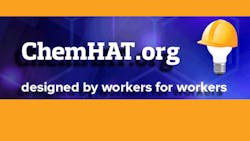Worker-Inspired Safer Chemicals Database Launched
Workers wanting safer workplaces now have a new tool to help them: the ChemHAT (Chemical Hazard and Alternatives Toolkit) database. The free, online database was designed in consultation with workers who deal withhazardous chemicals every day.
The ChemHAT database allows workers to quickly search 10,000 commonly used chemicals and see their acute and chronic health effects. In the near future, the database will provide the ability for users to identify safer alternatives to the chemicals they are using.
“Workers around the country deserve to know what dangers are presented by the chemicals they work with every day, but that information was too difficult to come by in many cases,” said IUE-CWA President Jim Clark. “Working with the BlueGreen Alliance, we were able to help jumpstart this important resource that is easy-to-use and ensures no worker ever has to be caught unaware of the dangers their workplace poses to them and their community.”
ChemHAT was designed – under the guidance of the IUE-CWA, the industrial division of the Communications Workers of America, and BlueGreen Alliance – by more than 130 workers represented by IUE-CWA, the United Steelworkers, United Auto Workers and Communications Workers of America. The workers examined existing databases and discussed what was needed to make a tool that would be easy and accessible to the widest range of people.
“ChemHAT is the first chemical information source geared specifically for workers, who are of course, at the most risk of exposure,” said Ernest Pacheco, district energy/environmental program coordinator for the Communications Workers of America, District 9 in California. “Perhaps even more importantly … is that it helps to reframe the issue to what it should have been for decades: What should we be using instead of this dangerous chemical?”
ChemHAT draws on the Healthy Building Network’s (HBN) Pharos Project, Chemical and Material Library, which includes a wide range of acute and chronic health effects ranging from skin rashes and eye irritants to birth defects, nervous system disorders and cancer. The database also identifies how workers most commonly come in contact with the materials, what available safety precautions they should take and what alternatives are available.
"Working in a chemical factory, it was an honor being a part of the process of this project. If one person is helped or kept safer, that will be great," said Dale Barrett, a IUE-CWA member who has worked at DuBois Chemicals since 1978 and currently is in the maintenance department for the company in Ohio.
“People like me are the first line of defense against dangerous chemical accidents in our workplace, community and environment,” said Debra Fisher, an IUE-CWA member from Dayton, Ohio, who works at Dmax, a parts supplier for the auto industry. “Now, if I have a question about what risks or how to handle something, I have a resource that I helped create that I know will give me what I need, when I need it.”
Representatives of the IUE-CWA, BlueGreen Alliance and the ChemHAT Working Group will be holding a webinar, “Trying ChemHAT On,” on Sept. 25 at 12:30 p.m. Eastern Time. During the webinar, the hosts will walk participants through the database and explain its operation and creation.
“The ChemHAT database will allow workers and businesses to make their own informed decisions about the chemicals they use everyday and the risks they take,” said David Foster, the executive director of the BlueGreen Alliance.
About the Author

Sandy Smith
Sandy Smith is the former content director of EHS Today, and is currently the EHSQ content & community lead at Intelex Technologies Inc. She has written about occupational safety and health and environmental issues since 1990.
